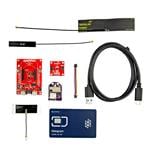- Home
- Braemac Blog
- Why Cloud Data Protection is Shifting to Developer Responsibility
Why Cloud Data Protection is Shifting to Developer Responsibility
About Jari Haiston
.png)
With the global cloud computing market size expected to jump to $1.27 trillion USD by 2028, cloud capabilities are rapidly becoming standard across consumer, retail, healthcare, and life science industries. Whether you’re developing an app, operating a global service, or simply backing up personal data, cloud offers a mix of speed, scalability, and cost-efficiency that makes it accessible to organizations and developers alike.
Yet, the common misconception persists that the cloud is inherently secure. In reality, cloud security is a shared responsibility where providers secure the infrastructure and now it’s up to developers to secure data pipelines, hardware interfaces, and firmware logic.
This distinctive transition has sparked a “shift-left” security mindset – not just in software, but in hardware development as well. Cloud-connected devices have to feature future-ready security in their design, embedded firmware, and cloud onboarding processes from day one.
What is the Shift Left Movement in Hardware Development?
From smart metering to wearables and industrial sensors, cloud connectivity is now an expected feature in many devices. Its mainstream adoption can be attributed to the increasing adoption of AI, machine learning (ML), big data, edge computing, and 5G. As billions of cloud-connected devices transmit data in real-time, each newly deployed endpoint deployed presents a potential entry point for attackers.
If cloud connectivity isn’t secured from the device-level up, vulnerabilities can quickly scale as fast as devices themselves. In July 2019, Capital One suffered a massive cloud data breach that impacted approximately 106 million individuals in the U.S. and Canada. Caused by a misconfigured Web Application Firewall (WAF) on Capital One’s site infrastructure, the attack ultimately allowed unauthorized access to highly sensitive customer data—including names, birthdates, Social Security numbers, and bank account details.
While the breach originated at the software level, scenarios like this highlight why the “shift left” movement is gaining momentum in both software and hardware development. “Shift left” in hardware development refers to the growing industry-wide push to deviate from the traditional product development timeline, where security is often addressed during deployment or even post-launch. As cloud-connected devices continue to multiply, hardware developers are being pulled to embed trust into the earliest stages of product design.
Secure By Design
As the number of cloud-connected devices continues to grow, developers and organizations must take a secure by design approach with proactive system-level security integrated at every stage of the product lifecycle.

Secure Boot and Hardware Root of Trust
Secure boot ensures that only authenticated, unaltered firmware is executed on a device by verifying cryptographic signatures at the device startup. By using hardware root of trust, such as Trusted Platform Modules (TPMs), Secure Elements, or ARM TrustZone, developers can anchor device identity and integrity from the onset.
OTA Update Infrastructure
No matter how secure a device is at launch, vulnerabilities can emerge post-deployment. Planning for secure over-the-air (OTA) updates are essential. A secure OTA infrastructure allows manufacturers to patch firmware remotely, mitigating newly discovered threats without needing physical access to deployed devices. Without this capability, devices risk permanent vulnerability.
IoT-Specific Threat Modeling and Testing
Cloud-connected hardware requires a unique approach to threat modeling that considers both cyber and physical attack surfaces. In IoT environments, developers must assess vulnerabilities like exposed debug ports, side-channel leakage, and insecure peripherals.
In addition to traditional code review, tools like static analysis, fuzz testing, and hardware-in-the-loop (HIL) simulation should be part of security validation processes to uncover flaws specific to embedded systems.
Leveraging Dev Kits with Cloud Connectivity as a Security On-Ramp
When considering how to integrate security from the onset of a development, sometimes all you need is the right platform. Braemac Americas | Symmetry Electronics is a leader in embedded and connected technologies. Our comprehensive portfolio includes the latest development kits that go beyond evaluation to jumpstart your security and cloud integration.
By leveraging kits with pre-integrated cloud SDKs—such as AWS IoT Core, Azure IoT Hub, or Google Cloud IoT Core—developers can quickly prototype secure connectivity while avoiding common pitfalls. These platforms often include built-in support for encrypted protocols like TLS and MQTT with mutual authentication, helping teams meet security best practices without building from scratch.
Moreover, many suppliers now integrate pre-loaded security services in their development tools. For example, Digi International’s TrustFence® device security framework simplifies the process of securing connected devices. Ideal for mission-critical applications, Digi TrustFence® includes secure boot, protects hardware and network ports, provides data authentication, and secures online connections all whole delivering ongoing threat measurement and monitoring services.
Combining Digi’s XBee® 3 Cellular LTE-M/NB-IoT module with a SparkFun development board, the SparkFun XBee® Cellular Kit delivers secure, cloud-ready connectivity out of the box. The integrated XBee® 3 module includes built-in BLE, GNSS, MicroPython programmability, and a hardware encryption chip for secure device identity and data transmission.
With support for secure remote access, TLS encryption, and Digi’s TrustFence security framework, it's ideal for applications requiring strong protection at the edge. The accompanying development board provides USB-C, battery power/charging, firmware programming, and access to all GPIOs and ADCs, making it a powerful and flexible platform for prototyping cloud-connected devices with built-in hardware security.
Built on the secure MediaTek Genio 1200 SoC, the VIA SOM-7000 EVK delivers a robust foundation for secure cloud-connected devices. It inherits key hardware-level protections like secure boot, TrustZone-based trusted execution, and anti-rollback support, helping ensure firmware integrity from the ground up.
With support for Android 13, Yocto 4.0, and Debian 12, developers gain flexibility to run secure cloud SDKs and containerized applications across various platforms. Combined with integrated Wi-Fi 6 and Bluetooth 5.2, the SOM-7000 EVK is well-equipped for secure wireless communication and remote update support in edge and industrial IoT deployments.



